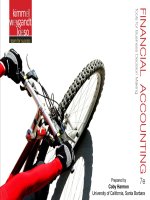Financial accounting 8e tool for busniess decision making chapter 10
Bạn đang xem bản rút gọn của tài liệu. Xem và tải ngay bản đầy đủ của tài liệu tại đây (2.65 MB, 89 trang )
10-1
10
Reporting and Analyzing Liabilities
Kimmel ● Weygandt ● Kieso
Financial Accounting, Eighth Edition
10-2
CHAPTER OUTLINE
LEARNING OBJECTIVES
10-3
1
Explain how to account for current liabilities.
2
Describe the major characteristics of bonds.
3
Explain how to account for bond transactions.
4
Discuss how liabilities are reported and analyzed.
LEARNING OBJECTIVE
1
Explain how to account for current liabilities.
WHAT IS A CURRENT LIABILITY?
A debt that a company expects to pay
1.
from existing current assets or through the creation of other current liabilities, and
2.
within one year or the operating cycle, whichever is longer.
Current liabilities include notes payable, accounts payable, unearned revenues, and accrued liabilities such as taxes,
salaries and wages, and interest.
10-4
LO 1
WHAT IS A CURRENT LIABILITY?
Review Question
To be classified as a current liability, a debt must be expected to be paid within:
10-5
a.
1 year.
b.
the operating cycle.
c.
2 years.
d.
(a) or (b), whichever is longer.
LO 1
NOTES PAYABLE
Written promissory note.
Usually require the borrower to pay interest.
Frequently issued to meet short-term financing needs.
Issued for varying periods of time.
Those due for payment within one year of the balance sheet date are usually classified as
current liabilities.
10-6
LO 1
NOTES PAYABLE
Illustration: First National Bank agrees to lend $100,000 on September 1, 2017, if Cole Williams Co. signs
a $100,000, 12%, four-month note maturing on January 1. When a company issues an interest-bearing
note, the amount of assets it receives generally equals the note’s face value.
Sept. 1
Cash
100,000
Notes Payable
100,000
10-7
LO 1
NOTES PAYABLE
Illustration: If Cole Williams Co. prepares financial statements annually, it makes an adjusting entry at
December 31 to recognize interest.
Dec. 31
Interest Expense
4,000 *
Interest Payable
4,000
* $100,000 x 12% x 4/12 = $4,000
10-8
LO 1
NOTES PAYABLE
Illustration: At maturity (January 1), Cole Williams Co. must pay the face value of the note plus interest. It
records payment as follows.
Jan. 1
Notes Payable
Interest Payable
100,000
4,000
Cash
104,000
10-9
LO 1
SALES TAXES PAYABLE
10-10
Sales taxes are expressed as a stated percentage of the sales price.
Selling company
►
collects tax from the customer.
►
remits the collections to the state’s department of revenue.
LO 1
SALES TAXES PAYABLE
Illustration: The March 25 cash register readings for Cooley Grocery show sales of $10,000 and sales taxes
of $600 (sales tax rate of 6%), the journal entry is:
Mar. 25
Cash
10,600
Sales Revenue
10,000
Sales Taxes Payable
600
10-11
LO 1
SALES TAXES PAYABLE
Sometimes companies do not ring up sales taxes separately on the cash register.
Illustration: Cooley Grocery rings up total receipts of $10,600. Because the amount received from the sale is
equal to the sales price 100% plus 6% of sales, (sales tax rate of 6%), the journal entry is:
Mar. 25
Cash
10,600
Sales Revenue
10,000
*
Sales Taxes Payable
* $10,600 ÷ 1.06 = $10,000
10-12
600
LO 1
UNEARNED REVENUES
Revenues that are received before goods are delivered or services are performed.
1.
Company increases (debits) Cash and increases (credits) a
current liability account, Unearned Revenue.
2.
When the company recognizes revenue, it decreases
(debits) the unearned revenue account and increases
(credits) a revenue account.
10-13
LO 1
UNEARNED REVENUES
Illustration: Superior University sells 10,000 season football tickets at $50 each for its five-game home
schedule. The entry for the sales of season tickets is:
Aug. 6
Cash
500,000
Unearned Ticket Revenue
500,000
As each game is completed, Superior records the earning of revenue.
Sept. 7
Unearned Ticket Revenue
100,000
Ticket Revenue
100,000
10-14
LO 1
CURRENT MATURITIES OF LONG-TERM DEBT
Portion of long-term debt that comes due in the current year.
No adjusting entry required.
Illustration: Wendy Construction issues a five-year, interest-bearing $25,000 note on January 1, 2016. This note
specifies that each January 1, starting January 1, 2017, Wendy should pay $5,000 of the note. When the company
prepares financial statements on December 31, 2016,
1.
What amount should be reported as a current liability? __________
2.
What amount should be reported as a long-term liability? ________
$5,000
$20,000
10-15
LO 1
DO IT!
1
Current Liabilities
You and several classmates are studying for the next accounting examination. They ask you to answer the following
questions.
1.
If cash is borrowed on a $50,000, 6-month, 12% note on September 1, how much interest expense would be
incurred by December 31?
2.
$50,000 × 12% × 4/12 = $2,000
The cash register total including sales taxes is $23,320, and the sales tax rate is 6%. What is the sales taxes
payable?
3.
$23,320 ÷ 1.06 = $22,000; $23,320 − $22,000 = $1,320
If $15,000 is collected in advance on November 1 for 3 months’ rent, what amount of rent revenue should be
recognized by December 31?
$15,000 × 2/3 = $10,000
10-16
LO 1
PAYROLL AND PAYROLL TAXES PAYABLE
The term “payroll” pertains to both:
Salaries - managerial, administrative, and sales personnel (monthly or yearly rate).
Wages - store clerks, factory employees, and manual laborers (rate per hour).
Determining the payroll involves computing three amounts: (1) gross earnings, (2) payroll
deductions, and (3) net pay.
10-17
LO 1
PAYROLL AND PAYROLL TAXES PAYABLE
Illustration: Assume Cargo Corporation records its payroll for the week of March 7 as follows:
Mar. 7
Salaries and Wages Expense
100,000
FICA Taxes Payable
Federal Income Taxes Payable
State Income Taxes Payable
7,650
21,864
Salaries and Wages Payable
2,922
67,564
Record the payment of this payroll on March 7.
Mar. 7
Salaries and Wages Payable
67,564
Cash
LO 1
10-18
67,564
PAYROLL AND PAYROLL TAXES PAYABLE
Payroll tax expense results from three taxes that governmental agencies levy on employers.
These taxes are:
10-19
FICA tax
Federal unemployment tax
State unemployment tax
LO 1
PAYROLL AND PAYROLL TAXES PAYABLE
Illustration: Based on Cargo Corp.’s $100,000 payroll, the company would record the employer’s
expense and liability for these payroll taxes as follows.
Payroll Tax Expense
13,850
FICA Taxes Payable
10-20
Federal Unemployment Taxes Payable
7,650
800
State Unemployment Taxes Payable
5,400
LO 1
PAYROLL TAXES
Review Question
Employer payroll taxes do not include:
10-21
a.
federal unemployment taxes.
b.
state unemployment taxes.
c.
federal income taxes.
d.
FICA taxes.
LO 1
ANATOMY OF A FRAUD
Art was a custodial supervisor for a large school district. The district was supposed to employ between 35 and 40 regular custodians, as
well as 3 or 4 substitute custodians to fill in when regular custodians were absent. Instead, in addition to the regular custodians, Art “hired”
77 substitutes. In fact, almost none of these people worked for the district. Instead, Art submitted time cards for these people, collected
their checks at the district office, and personally distributed the checks to the “employees.” If a substitute’s check was for $1,200, that
person would cash the check, keep $200, and pay Art $1,000.
Total take: $150,000
THE MISSING CONTROLS
Human resource controls. Thorough background checks should be performed. No employees should begin work until they have been
approved by the Board of Education and entered into the payroll system. No employees should be entered into the payroll system until
they have been approved by a supervisor. All paychecks should be distributed directly to employees at the official school locations by
designated employees or direct-deposited into approved employee bank accounts.
Independent internal verification. Budgets should be reviewed monthly to identify situations where actual costs significantly exceed
budgeted amounts.
10-22
LO 1
DO IT!
1b
Wages and Payroll Taxes
During the month of September, Lake Corporation’s employees earned wages of $60,000. Withholdings related to these
wages were $3,500 for Social Security (FICA), $6,500 for federal income tax, and $2,000 for state income tax. Costs
incurred for unemployment taxes were $90 for federal and $150 for state. Prepare the September 30 journal entries for (a)
salaries and wages expense and salaries and wages payable, assuming that all September wages will be paid in
October, and (b) the company’s payroll tax expense.
Sep. 30
Salaries and Wages Expense
60,000
FICA Taxes Payable
10-23
3,500
Federal Income Taxes Payable
6,500
State Income Taxes Payable
2,000
Salaries and Wages Payable
48,000
LO 1
DO IT!
1b
Wages and Payroll Taxes
During the month of September, Lake Corporation’s employees earned wages of $60,000. Withholdings related to these
wages were $3,500 for Social Security (FICA), $6,500 for federal income tax, and $2,000 for state income tax. Costs
incurred for unemployment taxes were $90 for federal and $150 for state. Prepare the September 30 journal entries for (a)
salaries and wages expense and salaries and wages payable, assuming that all September wages will be paid in October,
and (b) the company’s payroll tax expense.
Sept. 30
Payroll Tax Expense
FICA Taxes Payable
10-24
3,740
3,500
Federal Unemployment Taxes Payable
90
State Unemployment Taxes Payable
150
LO 1
LEARNING OBJECTIVE
2
Describe the major characteristics of bonds.
Bonds are a form of interest-bearing notes payable issued by corporations, universities, and
governmental agencies.
Sold in small denominations (usually $1,000 or multiples of $1,000).
When a corporation issues bonds, it is borrowing money. The person who buys the bonds (the
bondholder) is investing in bonds.
10-25
LO 2









